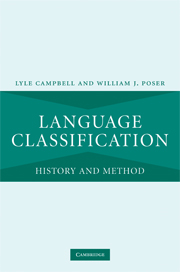Book contents
- Frontmatter
- Contents
- List of figures, tables, and charts
- Acknowledgments
- Preface
- 1 Introduction: how are languages shown to be related to one another?
- 2 The beginning of comparative linguistics
- 3 “Asiatic Jones, Oriental Jones”: Sir William Jones’ role in the raise of comparative linguistics
- 4 Consolidation of comparative linguistics
- 5 How some languages were shown to belong to Indo-European
- 6 Comparative linguistics of other language families and regions
- 7 How to show languages are related: the methods
- 8 The philosophical–psychological– typological–evolutionary approach to language relationships
- 9 Assessment of proposed distant genetic relationships
- 10 Beyond the comparative method?
- 11 Why and how do languages diversify and spread?
- 12 What can we learn about the earliest human language by comparing languages known today?
- 13 Conclusions: anticipating the future
- Appendix: Hypothesized distant genetic relationships
- References
- Index
6 - Comparative linguistics of other language families and regions
Published online by Cambridge University Press: 22 September 2009
- Frontmatter
- Contents
- List of figures, tables, and charts
- Acknowledgments
- Preface
- 1 Introduction: how are languages shown to be related to one another?
- 2 The beginning of comparative linguistics
- 3 “Asiatic Jones, Oriental Jones”: Sir William Jones’ role in the raise of comparative linguistics
- 4 Consolidation of comparative linguistics
- 5 How some languages were shown to belong to Indo-European
- 6 Comparative linguistics of other language families and regions
- 7 How to show languages are related: the methods
- 8 The philosophical–psychological– typological–evolutionary approach to language relationships
- 9 Assessment of proposed distant genetic relationships
- 10 Beyond the comparative method?
- 11 Why and how do languages diversify and spread?
- 12 What can we learn about the earliest human language by comparing languages known today?
- 13 Conclusions: anticipating the future
- Appendix: Hypothesized distant genetic relationships
- References
- Index
Summary
In the distant past, no one could speak, which is one reason that people were destroyed at the end of the First and Second Creations. Then, while the sun deity was still walking on the earth, people finally learned to speak (Spanish), and all people everywhere understood each other. Later the nations and municipios [towns] were divided because they had begun to quarrel. Language was changed so that people would learn to live together peacefully in smaller groups.
(Tzotzil oral tradition, Gossen 1984:46–7)Introduction
Much of the discussion of how language families are established so far has involved the history of Indo-European research, appropriately so, given its role in the development of comparative linguistics. In this chapter, we survey how several other important language families came to be established. The particular language families discussed are well known, universally accepted, were for the most part established relatively early in the history of linguistics, and so potentially had some impact on the development of the historical linguistics. We examine the methods used to establish these families in order to determine what criteria and principles were involved and what lessons we can take from them. We also consider language classification in Africa, Australia, and the Americas, with an eye towards the methods utilized in language classification in these regions.
- Type
- Chapter
- Information
- Language ClassificationHistory and Method, pp. 87 - 161Publisher: Cambridge University PressPrint publication year: 2008

